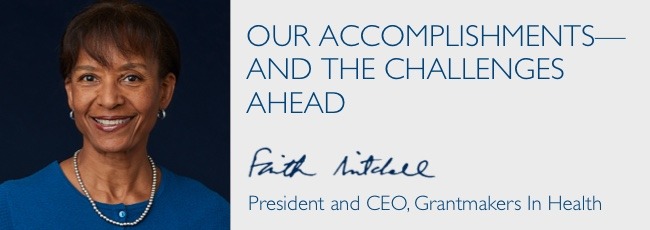
In November 2012, I was named president and CEO of GIH, after having been Vice President for Program and Strategy since 2007. Shortly afterward, I described the opening phases of what I called GIH 3.0, a term I chose because I was GIH’s third president. GIH 3.0 built on the past accomplishments of the organization, while positioning it to continue being a relevant and high-quality resource for the field. Inspired by ideas put forward by GIH’s staff, board, and Funding Partners, GIH 3.0 focused on bringing new thinking into what GIH did, how the work was done, and the strength of our internal organization and processes. It was informed throughout by GIH’s commitment to integrity, transparency, and fiscal responsibility; excellence; respect, responsiveness and innovation; collaboration; and diversity, equity, and inclusion. GIH 3.0 had three main components:
- expanding our connections and partnerships;
- providing leadership for the field through content development; and
- strengthening our infrastructure.
I’m pleased to present a few highlights of our accomplishments in these areas and proud to report that this is just a sampling of what we have accomplished over the past seven years. I am abidingly thankful for the strong staff and board and committed support and engagement of our Funding Partners that have made this work possible.
| Component 1: | Expand connections and partnerships in order to promote cross-sectoral learning and exchange among funders, reinforce the message that health is part of everything people do, and strengthen GIH’s role as a leading organization in the health sector. |
| Results: | GIH’s Philanthropy Support Partners program—with 14 sister philanthropy-support organization—enables us to collaboratively share information, develop programming, and advance the reach of health funders. Current partners are listed on our newly refreshed website. GIH increased health funders’ voice and ability to network at a national level by working in partnership with a variety of federal bodies, including offices of the White House and agencies within the Department of Health and Human Services, to promote public/private collaboration. GIH facilitated information exchange with “nontraditional actors” (i.e., organizations such as community development financial institutions that are pursuing health-related goals) and encouraged potential collaborations with Funding Partners. |
| Component 2: | Provide leadership for health philanthropy through content that reflects the interests of Funding Partners and also introduces them to emerging ideas and approaches. Support the professional development of foundation staff and trustees. |
| Results: | GIH expanded its range of programming to include strategy sessions (smaller, focused meetings), podcasts, and Bulletin articles with a wider selection of authors. The circulation of the Bulletin doubled. The annual conference was refreshed in response to Funding Partner feedback (and continues to evolve).
GIH introduced funders to leading thinkers and practitioners on a variety of issues, including access and quality, advocacy strategies, behavioral health, children and families, health equity, healthy eating/active living, integrative health, older adults, oral health, and population health. Scans of the field and infographics were introduced as new methods for tracking current funding trends, identifying opportunities for future activities and making recommendations to the field. GIH launched the Fund for Effective Philanthropy to meet the demand for professional development and organizational capacity building among both new and established philanthropic organizations. The fund reflects our vision of better health through better philanthropy and our belief that it is critically important to increase investments in foundations’ own governance and operations. We have been gratified by the enthusiastic response to our initial outreach and look forward to moving ahead in 2020 with programming to develop the human capital of foundation staff, senior management, and governing boards. |
| Component 3: | Strengthen GIH’s infrastructure in order to make efficient use of resources and reinforce our organizational performance. |
| Results: | Building capacity is an ongoing process. There are important milestones along the way, but the work is never finished. Since 2012, we have refreshed our website and Funding Partner database, improved our communications outreach, migrated to a new webinar platform, installed new financial systems, strengthened our development office, and reviewed our bylaws and board governance procedures. Much of this work was invisible to the outside world, but it resulted in organizational improvements that will sustain GIH and its mission for many years into the future. |
What’s Next?
Soon, GIH will have a new president and CEO, and I’ll be watching with interest as GIH 4.0 takes shape. One challenge that awaits the new president is the evolving landscape of health philanthropy. In the early 1980s, when GIH was founded, foundations were a primary mechanism for the charitable redistribution of wealth. Now, funding takes many forms, both formal (e.g., private philanthropic consulting firms) and less structured (e.g., crowd-sourcing). As philanthropy changes and foundations become a smaller portion of an expanding sector, how do they—and the organizations that serve them—maintain their relevance?
A second challenge is the increasing politicization of health issues. This trend has been accelerating for several years and, not surprisingly, has surfaced from time to time at GIH’s own gatherings. Notwithstanding, I am hopeful that GIH will be able to sustain its big tent of funders. The diversity of our Funding Partners—from all parts of the country, large and small foundations, corporate funders, conversion foundations, family foundations, etc.—is our strength. We may disagree about strategies and methods, but ultimately we cannot lose sight of our shared commitment to improving health for all people.
It’s been a pleasure working with all of you over the past 12 years. Onward!

